|
|
Serket
From Wikipedia, the free encyclopedia
Serket //, also known as Selket, Serqet or Selcis //, is the goddess of healing poisonous stings and bites in Egyptian mythology, originally the deification of the scorpion.[2]
Scorpion stings lead to paralysis and Serket's name describes this, as it means (she who) tightens the throat, however, Serket's name also can be read as meaning (she who) causes the throat to breathe, and so, as well as being seen as stinging the unrighteous, Serket was seen as one who could cure scorpion stings and the effects of other poisons such as snake bites.
In Ancient Egyptian art, Serket was shown as a scorpion (a symbol found on the earliest artifacts of the culture, such as the protodynastic period), or as a woman with a scorpion on her head. Although Serket does not appear to have had any temples, she had a sizable number of priests in many communities.
The most dangerous species of scorpion resides in North Africa, and its sting may kill, so Serket was considered a highly important goddess, and was sometimes considered by pharaohs to be their patron. Her close association with the early kings implies that she was their protector, two being referred to as the scorpion kings.
As the protector against poisons and snake bites, Serket often was said to protect the deities from Apep, the great snake-demon of evil, sometimes being depicted as the guard when Apep was captured.
As many of the venomous creatures of Egypt could prove fatal, Serket also was considered a protector of the dead, particularly being associated with poisons and fluids causing stiffening. She was thus said to be the protector of the tents of embalmers, and of the canopic jar associated with poison—the jar of the intestine—which was deified later as Qebehsenuf, one of the Four sons of Horus.
As the guard of one of the canopic jars and a protector, Serket gained a strong association with Aset (Isis), Nebet Het (Nephthys), and Neith who also performed similar functions. Eventually, later in Egyptian history that spanned thousands of years and whose pantheon evolved toward a merger of many deities, Serket began to be identified with Isis, sharing imagery and parentage, until finally, Serket became said to be merely an aspect of Isis, whose cult had become very dominant.
http://en.wikipedia.org/wiki/Serket
|
|
|
 Primer
Primer
 Anterior
2 a 14 de 14
Siguiente
Anterior
2 a 14 de 14
Siguiente
 Último
Último

|
|
|
Serket
De Wikipedia, la enciclopedia libre
Serket, antigua diosa protectora de la magia, símbolo del calor del Sol y también de la unión conyugal en cuanto al amor se refiere.
- Nombre egipcio: Serket-Heru o Selket. Nombre griego: Selkis.
Fue representada como mujer con un escorpión sobre su cabeza. También como escorpión de cabeza femenina, con cuernos o con el Sol. Algunas veces era representada como mujer con cabeza de leona.
Era hija de Ra, y a veces fue representada en Edfu como la esposa de Horus, o la madre de Horajti. Su hijo es Nehebkau en los Textos de las Pirámides.
Serket era una diosa benéfica que protegía el sarcófago del faraón. En los textos funerarios figura como la madre del difunto, al que amamanta. Protegía el vaso canopo de Kebehsenuf.
También prevenía de las picaduras de los escorpiones y las serpientes.
Se la llamó "la que facilita la respiración en la garganta", ya que la picadura del escorpión produce ahogo; también era mencionada como "la que posibilita la respiración del recién nacido" y "la que posibilita la respiración del difunto", en su renacimiento. Junto a Isis, Neftis y Neit, eran llamadas las "cuatro plañideras divinas".
Fue identificada con las diosas Isis y Seshat.
Era venerada en el delta del Nilo, en Edfu y Per-Serket. Los sacerdotes de Serket eran médicos y magos que curaban las picaduras de los animales venenosos.
- Referencias digitales
|
|
|
|
|
GOLDEN GATE/PUERTA DE ORO-RELACION DE FATIMA CON EL NUMERO 47
| grail in Simple Gematria Equals: 47 |
( |
g
7 |
r
18 |
a
1 |
i
9 |
l
12 |
) |
| grail in Simple Gematria Equals: 47 |
( |
g
7 |
r
18 |
a
1 |
i
9 |
l
12 |
) |
| raquel in Simple Gematria Equals: 74 |
( |
r
18 |
a
1 |
q
17 |
u
21 |
e
5 |
l
12 |
) |
| john in Simple Gematria Equals: 47 |
( |
j
10 |
o
15 |
h
8 |
n
14 |
) |
| jesus in Simple Gematria Equals: 74 |
( |
j
10 |
e
5 |
s
19 |
u
21 |
s
19 |
) |
| giza in Simple Gematria Equals: 43 |
( |
g
7 |
i
9 |
z
26 |
a
1 |
) |
| mark in Simple Gematria Equals: 43 |
( |
m
13 |
a
1 |
r
18 |
k
11 |
) |
| gize in Simple Gematria Equals: 47 |
( |
g
7 |
i
9 |
z
26 |
e
5 |
) |
| john in Simple Gematria Equals: 47 |
( |
j
10 |
o
15 |
h
8 |
n
14 |
) |
These are the four creatures of Ezekiel 1:10 and Revelation 4:7 which also relate to the four Apostles, the seasons, the elements and the guardians of the four directions.
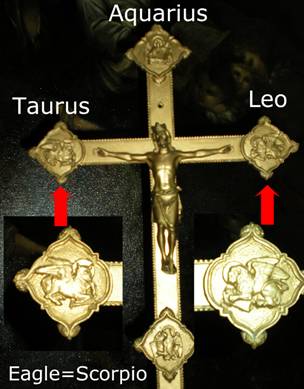
‘True Cross’ Cathedral Lisieux, France 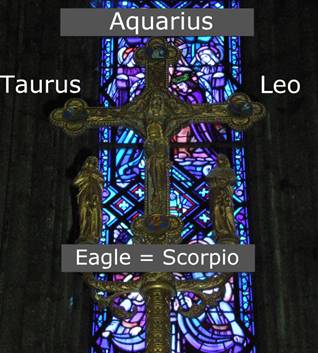
‘True Cross’, Baselique Notre Dame d’Ouvres La Delivrande, France
In churches, the four signs of the Zodiac often reoccur and are associated with ‘Judgment Day’ and the ‘End of Times’
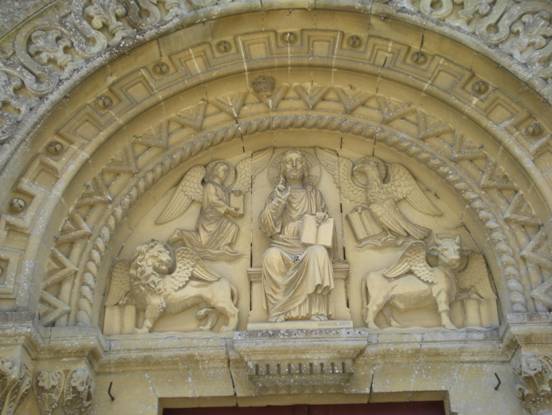
Jesus portrayed at the Last Judgment can often be found in the Tympanium above the entrance of churches and cathedrals. Notice, the lion (Leo) on the left, the bull on the right (Taurus), the angel on the left (Aquarius) and the eagle on the right ( Scorpio).
The four evangelists Luke, John, Mathew and Mark likewise have been associated with these four Zodiac signs as well:
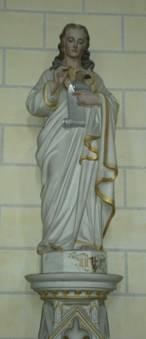 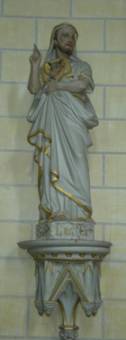 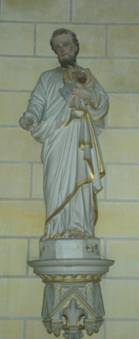 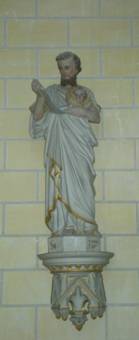
Mark = Scropio (Eagle), Luke = Taurus, John = Leo, Matthew = Aquarius
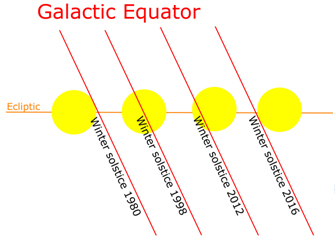 |
|
Winter Solstice Galactic Alignment of the Sun with the Galactic Equator
|
On Earth, the River Nile was the reflection of this great river in the sky, in accordance with the Hermetic principle "as above, so below." Herschel's earliest ingenious research has demonstrated that all of the pyramids along the river Nile represent constellations along the Milky Way, not just Orion! There are more than 50 pyramids in total, and their true meaning can only be deciphered when one considers the whole of Egypt.
During a Great Celestial Conjunction, the Sun crosses that great river in the sky, the Milky Way. Egyptologists explain that the solar God Ra (and Horus) required a boat because they sailed the Heavens from sunrise in the East to sunset in the West. At night, Ra travelled the Netherworld to be reborn in the morning at sunrise. Egyptologists reject the idea that the Egyptians understood the Precession of the Equinoxes and that the Sun also sojourns along the zodiac in a 26,000 year journey corresponding with the Precession Cycle.
In the Book of the Gates, the travel of the Sun at night along with the deceased pharaoh into the Netherworld is described. The Sun enters the Netherworld in the first hour just after sunset to be reborn in the morning at sunrise after a twelve hour nocturnal journey. There are many parallels, however, with the precessional journey of the Sun along the twelve signs of the zodiac to be discovered in the Book of the Gates. The 12 hours in the Book of Gates are structured into four groups of three hours, denoting a cross in the face of the clock. In the 12th hour Nun raises the solar barque with the scarab beetle of the Sun God from the primeval waters (Milky Way?), this is the hour of the rebirth of the Sun.
|
|
Left: Nun raises the solar barque from the primeval waters at ‘sunrise’, the time of the rebirth of the Sun.
|
During Ra's travel through all of the twelve signs of the zodiac in the precession cycle, he will be requiring a boat to twice cross that great river in the sky, the Milky Way! It is probably the only reason why the Egyptian deities required a Sun barque in the first place. Boats are used to cross waters, not skies, so it was used not for their nightly ecliptic travel from East to West through the Netherworld, but for their travels along the zodiac in the precession cycle. It is during this journey that the Sun would be required to cross the waters of the Milky Way at least twice. The Book of the Gates may therefore have been misinterpreted by Egyptologists as the nocturnal journey of the Sun simply because they reject the idea that the Egyptians understood Precession! Keep in mind that only twice per year on the equinox the day and night will be exactly 12 hours in length. It is therefore far more logical that the 12 hours in the Book of the Gates are in fact the 12 zodiacal Ages of the Precession Cycle.
Pharaohs in ancient Egypt were buried with their arms crossed holding Ankhs in their hands. This posture of the deceased pharaoh can be found on sarcophagus and in statues throughout Egypt. The Ankh represents a cross symbol.
|
|
Left: Grave statue of Tjel mayor of Memphis under Amenhotep III Dutch national museum of antiquities, Leiden.
Right: Sarcophagus with crossed arms and X cross on chest, Dutch National Museum of antiquities, Leiden.
|
Since the Greek inherited much of their wisdom from the Egyptians, it's more than reasonable to suspect that the gate or portal mentioned in the Book of the Gates through which the pharaoh enters the Netherworld is, in fact, the Gate of God that the Greek writer Macrobius writes about. The Gate of God was also called the Golden Gate, while the Gate of Men was called the Silver Gate. The very same Egyptian cross symbolism used by the pharaohs associated with the Golden and Silver gates of the soul (and the Sun) can still be recognized in the coat of arms of the Vatican, consisting of two crossed keys; one Golden, one Silver.
|
|
Silver and Golden cross in the Coat of Arms of the Vatican
|
The Golden Gate is the ecliptic Milky Way crossing at the Scorpio-Sagittarius nexus on the zodiac while the Silver Gate is the Milky Way ecliptic crossing at the Gemini-Taurus nexus. The Silver Gate was represented by the horns of Isis and the associated bull Taurus.
The Silver Gate is also clearly depicted in the Narmer Palette (3100 BC) named after the Egyptian pharaoh. The Narmer Palette shows the celestial goddess bull Bat (Taurus) with her horns bent over pointing exactly to the place of the rebirth of the Sun, the Silver Gate. The two cow's heads on top of the palette also represent Bat. In-between the two cow goddesses a hieroglyph is depicted representing the rising of the Sun in between two mountains on the horizon. It's a hieroglyph that is very similar to the Akhet hieroglyph with the same significance.
|
|
Bat on the left and right with the 'Akhet' glyph in between.
Dutch national museum of antiquities, Leiden
|
Bat was the goddess of the Milky Way considered to be a pool of Bat's cow milk. Bat was also the goddess of the human soul, the "Ba" that incarnated into human life form. Since the soul incarnated into human life passing through the Silver Gate (crossing of Milky Way and ecliptic), it's not surprising that Bat was both the goddess of the Milky Way and the human soul. Ba is a derivative of Bat, whereas "Ka" represents the human light-body. "Mer" represents the light of the Egyptian light-body-soul complex, the "Mer-Ka-Ba." Bat was also called the "Ba of Two Faces." Egyptologists are in the dark about her name and don't seem to understand that she was called this way, because there are actually two portals both to and from the Netherworld for the Ba to descend into the physical plane (Silver Gate) and ascend from the physical plane (Golden Gate). Both Hathor, Isis and Bat are all cow goddesses and Egyptologists have often pointed out the similarities between these goddesses depicted with cow-horns suspecting that they may have the same origins...they all represent the Silver Gate.
At the bottom of the Narmar palette in-between the horns of the bull, the very same hieroglyph is depicted as the one shown between two Bat bulls on top of the palette. This Akhet-like hieroglyph symbolises the rising Sun on the horizon.
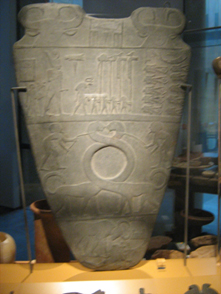 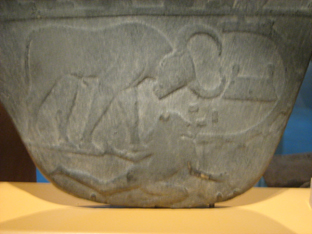 |
The Narmar Palette, bull in close up on the right. The bull is leaning towards the Silver Gate near the Gemini-Taurus nexus depicted in between the horns. The hieroglyph in between the horns resembles an Akhet glyph and represents the Silver Gate.
Dutch national museum of antiquities, Leiden
|
On the other side of the Narmer palette two identical men, hence suggesting twins are depicted. They are both looking over their shoulders to a particular square over the left man’s shoulder. We surmise that the twins represent Gemini which would make sense since the actual ecliptic Milky Way crossing of the Silver Gate occurs in 5° Gemini (sidereal zodiac) and the square could therefore be suggesting the Silver Gate.
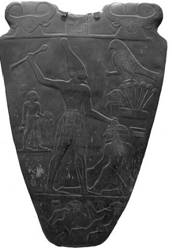 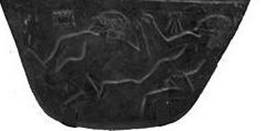
Narmer palette backside
Dutch national museum of antiquities, Leiden
The author Audrey of the website "Ancient Egypt" writes while referring to the Narmar Palette: "They present an overview of the astronomical event which occurred on September 21st in 4468BCE, when the Autumn (Fall) Equinox of the Sun was in conjunction with the Milky Way."
At the Autumnal Equinox, the Sun was indeed at the Milky Way, however at the Golden Gate. At the Vernal Equinox of 4468 BC, the Sun resided at the Silver Gate. The author (Audrey) does not seem to realise that this moment represented a Great Celestial Conjunction when the equinox axis (Vernal and Fall) aligned with the Galactic Equator and the Sun resided at the Gates of the Gods.
Instead, while interpreting the hieroglyphs of the 10 decapitated figures near the Solar Barque, he writes quote, "The full meaning of the hieroglyph can therefore be interpreted as 'the Sun at a sacred gateway, opening or portal'..."
While Hathor, Isis and Bat are all cow goddesses, Egyptologists have often pointed out the similarities between these goddesses depicted with cow-horns suspecting that they may have the same origins. . . .
We suggest that they all represent the Silver Gate.
There is an even older Egyptian goddess that later was associated with Isis and Hathor. Her name is Serket and she was the deification of the scorpion goddess who healed stings and bites. Eventually, Serket was associated with Isis and she was said to be just an aspect of Isis. Serket and Isis can therefore be regarded as the ‘Ba of Two Faces’. While Isis represents the Silver Gate at the Gemini-Taurus nexus, Serket is her counterpart and she represents the Golden Gate at the Scorpio-Sagittarius nexus. This is why she’s wearing the scorpion on her head while she joined Ra in his barque on his journey around the zodiac in a Great Year.
 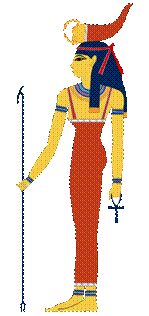
Left: Isis with the solar disk in between the horns representing the Silver Gate
Right: Serket with the scorpion at her head representing the Golden Gate.
The sacred Egyptian scarab beetle is a metaphor for the Sun in the precession cycle whereas the dung ball represents the Sun. The scarab beetle rolls its dung ball with his hind legs backwards, symbolizing the backward motion of the Sun through the zodiac in the precession cycle. Since the scarab beetle has many similarities with a scorpion, we surmise that Serket and the scarab beetle both represent the Golden Gate in Egyptian mythology.

Right: Scarab representing the crossing of the ecliptic and Milky Way
near Sagittarius-Scorpio nexus. The dung ball of Scarab beetle is the Sun.
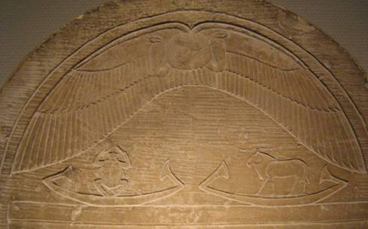
On the left, the scarab beetle in a barque. On the right, the bull with the horns in a barque. They represent the places where Ra requires a barque to cross the Milky Way river in the precession cycle and thus represents the galactic equator.
|
|
|
|
|
Susana Alegre García 01 de Noviembre de 2008
Última actualización el 12 de Noviembre de 2008
Época: Dinastía XVIII, reinado del faraón Tutankhamón (1334-1325 a.C.)
Dimensiones: Altura: 9 cm. Ancho: 10'5 cm.
Material: oro, lapislázuli, cornalina, turquesa, feldespato…
Lugar de conservación: Museo de El Cairo
Lugar de localización: tumba de Tutankhamón en el Valle de los Reyes (KV 62)[1]

Foto 1. Pectoral con escarabajo alado de Tutankhamón. Foto en Foto en T.G. HENRY JAMES, Tutankamón, Barcelona, 2001, p. 231.
Entre los magníficos hallazgos que iba a deparar la exploración de la tumba de Tutankhamón, una de las más sugestivas sorpresas se localizó en el interior de un cofre situado en la cámara del Tesoro (Fig. 2 )[2]. Allí, removidas por la búsqueda de antiguos saqueadores (Fig. 3), Howard Carter encontró un grupo de joyas entre las que se encontraba un pectoral que representa un escarabajo alado[3]. Se trata, sin duda, de una de las representaciones más espectaculares y atractivas de uno de los temas más reiterados en la iconografía egipcia(Fig. 1).
El insecto, realizado en lapislázuli, despliega unas vistosas alas que se curvan y culminan con la figura de un disco solar. El diseño se consigue gracias a las incrustaciones engastadas con el procedimiento del cloisonné, una técnica de gran tradición en el Egipto faraónico. En la parte del reverso es visible una única y gran anilla de sustentación, que permitía que la joya se colgara posiblemente de un cordón o cadena. El lecho de oro también se presenta sucintamente ornamentado, destacándose mediante cincelado las formas del escarabajo, de sus alas, etc. (Fig. 4). Lo cierto es que el trabajo resulta un tanto burdo y son apreciables desalineaciones e imprecisiones[4].
En lo que respecta a los recursos plásticos utilizados en el pectoral (Fig. 1), hay que destacar el contraste cromático conseguido en las alas, así como el diseño que hace que se curven y extiendan hacia el disco solar. Se trata de un composición simétrica, con un cuidado efecto ascendente y que consigue orientar la atención hacia el disco solar. También se puede observar que en el diseño de las alas se dejó una zona sin incrustaciones, lo que proporciona una superficie algo extensa de oro a cada lado de las patas delanteras del escarabajo. Así se enfatiza la presencia de estas patas, impidiendo que pudieran quedar diluidas entre el colorido y abigarramiento de las alas, donde el color azul, el mismo que el de las patas del animal, es dominante.

Foto 2. Cofres de la sala del Tesoro. En el interior del primer cofre mostrado en esta foto, con remates ornamentales claros, fue localizado el pectoral con escarabajo de Tutankhamón junto a otras magníficas joyas. Foto en http://www.ashmolean.org/gri/carter/267-p1091.html
Las otras dos patas del animal, de relevancia secundaria, prácticamente se confunden con los tonos azules imperantes. También llama la atención que el animal tenga únicamente cuatro patas, cuando en realidad el escarabajo pelotero dispone de seis. Parece que las extremidades centrales se sacrificaron para no interferir en el diseño y conseguir un resultado mucho más armónico.
El disco solar, de dimensiones destacables, atrae la atención. El color de la cornalina ayuda a realzar su presencia, ya que en el resto de la joya imperan los tonos azules y verdosos, relegando el rojo únicamente
a pequeños detalles que sirven para otorgar ritmo y equilibro a la composición. Además, el disco se hace especialmente llamativo al situarse sobre un eje de simetría y gracias al diseño de las alas. Unas alas que consiguen que el conjunto del pectoral adquiera una forma redondeada, reiterando la alusión al disco y potenciando aún más el concepto solar implícito a la simbología de la joya. A ello sumar que para subrayar aún más la imagen del sol se realizó un ribeteado bastante ancho en el entorno de la incrustación, marcando un perfil de oro en su entorno que no aparece rodeando ningún otro elemento del pectoral.

Foto 3. Interior del cofre de la sala del Tesoro. Estado algo revuelto del interior del cofre donde fue localizado el pectoral del escarabajo de Tutankhamón. Foto en http://www.ashmolean.org/gri/carter/267-p1168.html
El escarabajo pelotero es común en Egipto, de modo que también en la antigüedad resultaba habitual la observación de los esfuerzos de dichos animales arrastrando y haciendo girar pelotas de estiércol. En esta imagen los egipcios encontraron una metáfora sencilla y efectiva, que permitía vincular el animal y el movimiento del astro solar a través del firmamento. Es decir, el dios escarabajo encarnaba la poderosa fuerza que consigue que el sol se eleve cada mañana en el horizonte y se desplace inexorablemente hacia el oeste.
Pero, además, hay que tener en cuenta que el escarabajo esconde bajo el subsuelo la bola de estiércol, colocándola en una especie de cámara en la que también se entierra y muere. Antes, no obstante, habrá puesto su huevo en el interior de la pelota que servirá de alimento a la larva y que permitirá su inicial desarrollo. Poco después, en el lugar del enterramiento, un nuevo escarabajo recién nacido emerge a la superficie. De modo que de alguna manera es como si un escarabajo viejo y cansado consiguiera renovarse para emprender una nueva existencia. Lo cierto es que no es de extrañar que los antiguos egipcios consideraran que el coleóptero goza de la capacidad de renacimiento y autogeneración, y que lo divinizaran dándole el nombre de Jepri "el que viene a la existencia" o "el que viene a ser".

Foto 4. Reverso del pectoral del escarabajo de Tutankhamón. Foto en H. STIERLIN, L'or des pharaons, París, 1993, p. 57.
Por sus implicaciones Jepri era fundamental en el contexto cosmogónico y la mitología le atribuía el poder de mover la gigantesca bola que ilumina el conjunto de la creación, convirtiéndose en motor de toda existencia. Una existencia que además es capaz de regenerar y de perpetuar, por lo que el escarabajo se vinculó estrechamente con las creencias de ultratumba y con la propiciación de la eternidad. Ciertamente el periplo vital del insecto implicaba un símil o referente en lo que respecta a la culminación de las expectativas funerarias: enterrarse para lograr la eternidad con energía renovada, emergiendo desde la arena del desierto hacia una nueva vida.
El escarabajo pelotero es una de las imágenes más tradicionales de la iconografía egipcia, siendo uno de los símbolos más habituales. Su representación se convirtió en un amuleto muy popular, al que se otorgaban capacidades protectoras y propiciadoras, y del que se han localizado innumerables ejemplos. Incluso sobre las momias, en la zona del pecho, frecuentemente se colocó un tipo de amuleto denominado "escarabajo de corazón", asimilando este poderoso motor de la existencia con el órgano motor del cuerpo humano y, según la creencia egipcia, también sede del pensamiento y la conciencia[5].

Foto 5. Colgante con escarabajo de Tutankhamón. Esta joya tiene el mismo diseño que el pectoral con escarabajo alado (Fig. 1), aunque se trata de una pieza más pequeña, en la que se ha eliminado el closionné en las zonas de las alas y se ha reducido la presencia de materiales preciosos. Foto en C. ALDRED, Jewels of the Pharaohs. Egyptian jewelry of the Dynastic Period, Londres, 1978.
|
|

Foto 6. Pectoral de Tutankhamón. Esta pieza fue localizada sobre la momia del monarca, junto con un conjunto magnífico de joyas. El escarabajo alado y el nombre del monarca vuelven a ser aquí el centro de la composición, donde también encuentra relevancia la simbología lunar. Foto en T.G. HENRY JA MES, Tutankamón, Barcelona, 2001, p. 218.
|
Dada sus profundas implicaciones no es sorprendente que la imagen del escarabajo pelotero se representara repetidamente en el ámbito de la tumba de Tutankhamón. Sin embargo, el escarabajo de este pectoral tiene unas peculiaridades que lo hacen todavía más rico a nivel referencial: la parte inferior de la joya se cierra con la forma del signo jeroglífico neb- y con tres pequeñas franjas verticales de color rojo que en escritura aluden al plural[6]. Estos elementos, conjuntamente con el escarabajo y el disco solar, integran el cartucho Nebjeperure, y con tres pequeñas franjas verticales de color rojo que en escritura aluden al plural[6]. Estos elementos, conjuntamente con el escarabajo y el disco solar, integran el cartucho Nebjeperure,  . Es decir, el pectoral, de manera ricamente plástica, escribe el Nombre de Trono del monarca. Este juego criptográfico, que fusiona el nombre del rey con la figura del escarabajo sosteniendo entre sus patas el disco del sol, es un recurso habitual entre las joyas de Tutankhamón (Fig. 5 y 6) y está presente en muchos objetos del ajuar localizado en su tumba (Figs. 7 y 8). . Es decir, el pectoral, de manera ricamente plástica, escribe el Nombre de Trono del monarca. Este juego criptográfico, que fusiona el nombre del rey con la figura del escarabajo sosteniendo entre sus patas el disco del sol, es un recurso habitual entre las joyas de Tutankhamón (Fig. 5 y 6) y está presente en muchos objetos del ajuar localizado en su tumba (Figs. 7 y 8).

Foto. 7. Tapa de caja de espejo de Tutankhamón. Foto en T.G. HENRY JAMES, Tutankamón, Barcelona, 2001, p. 197.
En el antiguo Egipto el nombre era considerado un componente fundamental en la identidad y se consideraba directamente asociado a la esencia de los individuos. En el caso de los reyes y de los dioses, los nombres alcanzaba una dimensión especialmente relevante y se les atribuían poderes excepcionales. De ahí que representar del escarabajo dando vueltas al disco solar e integrando a la vez los jeroglíficos que escriben el cartucho del rey, sea una imagen con la capacidad de alcanzar una gran significación. De hecho, trasformar los signos aislados que integran el nombre del faraón y convertirlos en una narrativa mitológica, presentaban al faraón de manera indiferenciable de la divinidad: la esencia del escarabajo divino y la del monarca se fusionan, sus naturalezas se confunden. La magia de la imagen y del jeroglífico convierten a Tutankhamón y Jepri en un único ser.

Foto 8. Detalles de una caja de cosméticos de Tutankhamón. Foto en Foto en H. STIERLIN, L'or des pharaons, París, 1993, p. 50.
Escribir el nombre de un individuo con materiales preciosos puede que sea un acto de ostentación[7], pero en este pectoral la vanagloria va más allá y se vincula con motivaciones de legitimación de la monarquía. En el marco de las estrategias de divinización, en las que se apoyó durante milenios la autoridad de los faraones, el pectoral permitía identificar al monarca con el poder revitalizador y todopoderoso del astro solar ente las patas del escarabajo. Quien se presentara ante Tutankhamón, cuando éste portara la joya, tendría la visión de un monarca rodeado de fasto sobre cuyo pecho palpitaba el motor que da vida al conjunto del cosmos.
[1] J. CARTER y A.C. MACE, The Tomb of Tut.ankh.amen, 3 vols., Londres, 1923-1933.
[2] Pieza nº 267 del inventario.
[3] Pieza nº267a del inventario.
[4] Aún tratándose de una joya realizada con los más preciosos materiales, algunos de sus rasgos hacen pensar en una cierta precipitación. Parece que el objetivo de quienes crearon esta joya se centraba más en alcanzar un resultado efectista y ostentoso, que en conseguir generar una obra perfecta y detallista. No obstante, lo cierto es que el resultado final consigue ser armonioso y elegante, convirtiendo a esta joya en una realización espectacular. Puede que el pectoral adolezca de la meticulosidad, por ejemplo, perceptible en ciertas joyas del Imperio Medio, pero también es obvio que los joyeros de Tutankhamón se movieron por otros retos y otros objetivos.
[5] El "escarabajo de corazón" debía proteger al difunto durante el juicio ante el tribunal de Osiris, el trance más complejo al que debía enfrentarse en su camino hacia el Más Allá. Para intensificar su eficacia mágica y propiciar que el propio corazón no pudiera realizar declaraciones que delataran negativamente al difunto, sobre el "escarabajo de corazón" se realizaba la inscripción del Capítulo 30 del Libro de los Muertos.
[6] En lo que respecta a las líneas verticales de cornalina que indican el plural, llama la atención que la central quede levemente desplazada. Ello puede tener que ver con el objetivo de no establecer un eje de simetría clara en la parte baja de la joya, cosa que habría podido desequilibrar un poco la llamada de atención que el conjunto del diseño orienta hacia la parte superior. También la presencia perfectamente alineada podría darle una entidad protagonista a la línea que no era la deseada y, a la vez, en esa posición podría desfigurar el perfil bajo del escarabajo, animal que sí es protagonista central. Sea como sea, lo cierto es que difícilmente puede tratarse de un defecto en la confección del pectoral, parece un efecto buscado ya que otras joyas de Tutankhamón, que tienen también estas tres líneas bajo el escarabajo, lucen la idéntica y curiosa desalineación (ver por ejemplo Fig. 5 y 6)
[7] El oro, las piedras preciosas, etc. gozaron en Egipto también de un gran simbolismo e incluso las distintas partes del cuerpo de los propios dioses se identificó con estos materiales preciosos. De modo que el mero hecho de escribir el nombre de un monarca con estos materiales es algo que integra una gran carga simbólica.
|
|
|
|
|
CARTA A UN CIENTÍFICO Time Temple letterFrom a letter to a scientist: "The conclusion should be made upon a probability, that it may be just coincidental, that these 14 lines are forming a very accurate model of the inner planetary system, showing also a precise time position, that coincidentally matches (relative to the end of Mayan Calendar) the beginning of the final 1260 days time period, mentioned both in the Old and New Testament (surely one of the most remarkable and disputed episodes in the Book), a time period, which allows (and was supposedly measured for) to show in a relatively short period of time, when, and what the End is all about - the mystery of death and the origin of life. After the probability is calculated, and if the figure shows that all what was presented is most likely just coincidental, then there would be no need to draw any conclusions. Yet if the probability figure shows, that it is most likely not a coincidence (if the figure is close to zero), then 12 21 '12 should be taken very seriously, and it becomes also more clear why these structures were built, and why so massive.
 |
Click para ampliar |
 As you probably know, at the end of 12th century, the son of Saladin, Aziz, led a muslim army "against the pyramids". The idea was to demolish the Giza complex completely, in order to show the superiority of Islam. They started with demolishing the smallest, the third pyramid. After about eight month of hard labour they realized how much time and money it would take to demolish all three pyramids. The minor damage made to the third pyramid is still visible. The birth of all civilizations ca 5000 years ago (now also called Great Divide), has been marked by many temple-structures, simultaneously emerging in different continents. These structures have proved to be carrying a certain information about the beginning, the development and also the end of the current era, while at the same time they have been clearly enhancing the growth of reasoning throughout the era (despite all obstacles, stupidity and controversy involved), through study and arts. There is a simple rule: to define the end of a circle, the beginning must be defined first. The current era began with the pyramids." Thoth's Time Temple - Giza Alignment Code Time-Shift TIME-SHIFT CODE EN ESTE VIDEO se muestra una interesante hipótesis, a partir de la cuál el complejo de gizeh replica la posición de los planetas interiores (marte venus mercurio y la tierra), el 9/julio/2009 - 3 años y medio previos al 21/Diciembre/2012 - 1260 dias antesLa hipótesis es discutible (aunque recomiendo el video y la página encarecidamente), partiendo de un alineamiento geométrico en el que el sol (posición central) tenga un tamaño menor......... siendo RA, lo que significaba para los egipcios. Aunque por otra parte podríamos considerar que las piramides (como así posiblemente sea), no fueron construidas por los egipcios, sino tomadas como legado de una civiliación anterior. Entonces el monumento es un "legado del tiempo" y ese detalle sobre el tamaño del sol quedaría en algo sin importancia.
 |
Click para ampliar |
 El número 1260 días, aparece en le antigüo y nuevo testamento "Revelation 11:11. The verse includes the words, "three and a half days." At one point, I re-read some dreams I had received, and two of them made a connection. In one of them a voice said, "The children were born in the sign of 42." In the other dream, I saw "Trinity 11:2." I looked up Revelation 11:2, and found that it speaks of the holy city being trampled over for 42 months. I then realized 42 months is is 3 1/2 years, perhaps connecting with the 3 1/2 days in Rev. 11:11. I then read the next verse, Rev. 11:3, which speaks of 1260 days. This was not quite 3 1/2 years, but dividing 1260 by 3.5 gives 360. It's like 3 1/2 times around a circle, again matching the 3 1/2 in the other verses. At the time, I did not know that the Hebrew calendar had 30-day months, but I now see that 1260 days is another way of indicating 3 1/2 years" REVELACIÓN 11:11 THE CODE OF CARL MUNCK, AND ANCIENT GEMATRIAN NUMBERS - PART ONECarl Munck CODE "¿Quién de ustedes que sea padre, si su hijo le pide[f] un pescado, le dará en cambio una serpiente? 12 ¿O si le pide un huevo, le dará un escorpión? 13 Pues si ustedes, aun siendo malos, saben dar cosas buenas a sus hijos, ¡cuánto más el Padre celestial dará el Espíritu Santo a quienes se lo pidan!" (Lucas 11:11) -Lucas - Great Cross - Heavens comes to Earth-  <****** width="640" height="360" src="http://www.youtube.com/embed/Nms_2A2dJUI?feature=player_detailpage" frameborder="0" allowfullscreen> "Two infinite power ballons. One -the plus- connected to the other -the minus- through the very center - the Zero  (Absolute ZERO point) TWIN TOWERS - JACHIN & BOAZ - Collapses  ZERO GROUND ERA -BLESSING [IMG]http://gothamist.com/***********/jen/2008_04_popegz7.jpg[/IMG] The Time Temple ¿Porqué (a día de hoy lo sabemos) el estado actuál de nuestro universo muestra que el 96% de la materia es oscura? ¿Cómo es que desde el orígen de todo (big ban - singularidad) hace 13 billones de años ha pasado ese enorme porcentaje de ser luz visible a luz no visible? A dónde ha ido? Desde entonces cuántos ciclos de luz-oscuridad ha habido y cuál es su duración?Sabemos que los agujeros negros se tragan la luz. Si nuestro Universo es dual, debe de haber "otro lado del espejo" dónde el 96% de materia sea visible y sólo el 4% antimateria...... Quizás desde luego sea un signo de un ciclo (13-baktun) que termina
 |
Click para ampliar |
Última edición por Dante2010; 02-sep-2012 a las 22:46
|
|
|
|
Es probable, los 60 grados del campo magnetico son un hecho confirmado por el Voyager, y tambien deberiamos entrar en la era de Acuario si es que ya no entramos, el codigo de la rueda de Ezequiel, por lo tanto si no es este año calculo estaremos muy proximos.
 |
Click para ampliar |
 La lapislazuli se encuentra en forma de rombo dodecahedro, casualmente es la piedra utilizada simbolicamente por Inana - Ishtar para bajar al inframundo. |
|
|
|
 |
Click para ampliar |
 Si gracias, Recordemos que el escarabajo equivale al signo de Cancer o sea el cangrejo
 |
Click para ampliar |
|
|
|
|
|
|
|
|
Busqueda para estiercol
1. Éxodo 29:14: Pero la carne del becerro, y su piel y su estiércol, los quemarás a fuego fuera del campamento; es ofrenda por el pecado.
2. Levítico 4:11: Y la piel del becerro, y toda su carne, con su cabeza, sus piernas, sus intestinos y su estiércol,
3. Levítico 8:17: Mas el becerro, su piel, su carne y su estiércol, lo quemó al fuego fuera del campamento, como Jehová lo había mandado a Moisés.
4. Levítico 16:27: Y sacarán fuera del campamento el becerro y el macho cabrío inmolados por el pecado, cuya sangre fue llevada al santuario para hacer la expiación; y quemarán en el fuego su piel, su carne y su estiércol.
5. Número 19:5: y hará quemar la vaca ante sus ojos; su cuero y su carne y su sangre, con su estiércol, hará quemar.
6. Jueces 3:22: de tal manera que la empuñadura entró también tras la hoja, y la gordura cubrió la hoja, porque no sacó el puñal de su vientre; y salió el estiércol.
7. 1 Reyes 14:10: por tanto, he aquí que yo traigo mal sobre la casa de Jeroboam, y destruiré de Jeroboam todo varón, así el siervo como el libre en Israel; y barreré la posteridad de la casa de Jeroboam como se barre el estiércol, hasta que sea acabada.
8. 2 Reyes 6:25: Y hubo gran hambre en Samaria, a consecuencia de aquel sitio; tanto que la cabeza de un asno se vendía por ochenta piezas de plata, y la cuarta parte de un cab de estiércol de palomas por cinco piezas de plata.
9. 2 Reyes 9:37: y el cuerpo de Jezabel será como estiércol sobre la faz de la tierra en la heredad de Jezreel, de manera que nadie pueda decir: Esta es Jezabel.
10. 2 Reyes 18:27: Y el Rabsaces les dijo: ¿Me ha enviado mi señor para decir estas palabras a ti y a tu señor, y no a los hombres que están sobre el muro, expuestos a comer su propio estiércol y beber su propia orina con vosotros?
11. Job 20:7: Como su estiércol, perecerá para siempre; Los que le hubieren visto dirán: ¿Qué hay de él?
12. Salmos 83:10: Que perecieron en Endor, Fueron hechos como estiércol para la tierra.
13. Isaías 36:12: Y dijo el Rabsaces: ¿Acaso me envió mi señor a que dijese estas palabras a ti y a tu señor, y no a los hombres que están sobre el muro, expuestos a comer su estiércol y beber su orina con vosotros?
14. Jeremías 8:2: y los esparcirán al sol y a la luna y a todo el ejército del cielo, a quienes amaron y a quienes sirvieron, en pos de quienes anduvieron, a quienes preguntaron, y ante quienes se postraron. No serán recogidos ni enterrados; serán como estiércol sobre la faz de la tierra.
15. Jeremías 9:22: Habla: Así ha dicho Jehová: Los cuerpos de los hombres muertos caerán como estiércol sobre la faz del campo, y como manojo tras el segador, que no hay quien lo recoja.
16. Jeremías 16:4: De dolorosas enfermedades morirán; no serán plañidos ni enterrados; serán como estiércol sobre la faz de la tierra; con espada y con hambre serán consumidos, y sus cuerpos servirán de comida a las aves del cielo y a las bestias de la tierra.
17. Jeremías 25:33: Y yacerán los muertos de Jehová en aquel día desde un extremo de la tierra hasta el otro; no se endecharán ni se recogerán ni serán enterrados; como estiércol quedarán sobre la faz de la tierra.
18. Ezequiel 4:15: Y me respondió: He aquí te permito usar estiércol de bueyes en lugar de excremento humano para cocer tu pan.
19. Nahum 3:6: Y echaré sobre ti inmundicias, y te afrentaré, y te pondré como estiércol.
20. Sofonías 1:17: Y atribularé a los hombres, y andarán como ciegos, porque pecaron contra Jehová; y la sangre de ellos será derramada como polvo, y su carne como estiércol.
21. Malaquías 2:3: He aquí, yo os dañaré la sementera, y os echaré al rostro el estiércol, el estiércol de vuestros animales sacrificados, y seréis arrojados juntamente con él.
ESTIERCOL / ESTHER-COLON / MERCURIO-ORION ISHTAR GATE (AGUJERO DE GUSANO)
|
|
|
|
|
|
 Gods and Goddesses Gods and Goddesses
Hathor

Key Facts
| Other names |
Hah-Thor |
| Year of origin |
2700 BCE |
| Location |
|
| Parent(s) |
|
| Partner(s) |
|
| Children |
|
| Aspect(s) |
|
| Major Centre(s) |
|
| Period of worship |
|
Background
Hathor (Pronounced Hah-Thor) (Egyptian for house of Horus) was originally a personification of the Milky Way, which was seen as the milk that flowed from the udders of a heavenly cow. Hathor was an ancient goddess, and was worshipped as a cow-deity from at least 2700 BC, during the second dynasty.
Her worship by the Egyptians goes back earlier however, possibly, even by the Scorpion King who ruled during the Protodynastic Period before the dynasties began. His name, Serqet, may refer to the goddess Serket.
Hathor is referred to as She with Two Faces, which is symbolic both for her ability to be cruel to humanity as well as kind and hence her ability to change shape from a woman into a bull or a serpent.
It was said that, with her motherly character, Hathor greeted the souls of the dead in Duat, and proffered them with refreshments of food and drink. She also was described sometimes as mistress of the acropolis.
Hathor also became associated with the menat, the turquoise musical necklace often worn by women. A hymn to Hathor says:
Thou art the Mistress of Jubilation, the Queen of the Dance, the Mistress of Music, the Queen of the Harp Playing, the Lady of the Choral Dance, the Queen of Wreath Weaving, the Mistress of Inebriety Without End.
Essentially, Hathor had become a goddess of Joy, and so she was deeply loved by the general population, and truly revered by women, who aspired to embody her multifaceted role as wife, mother, and lover. In this capacity, she gained the titles of Lady of the House of Jubilation, and The One Who Fills the Sanctuary with Joy.
The worship of Hathor was so popular that more festivals were dedicated to her honor than any other Egyptian deity, and more children were named after this goddess than any other deity. Even Hathor's priesthood was unusual, in that both women and men became her priests.
Mythology
In the tale following the war, Ra (representing the pharaoh of Upper Egypt) was no longer respected by the people (of Lower Egypt) and they ceased to obey his authority, which made him so angry that he sent out Sekhmet (war goddess of Upper Egypt) to destroy them. Sekhmet became bloodthirsty and the slaughter was great because she could not be stopped.
As the slaughter continued, fear that all of humanity would be destroyed arose among the deities and Ra was charged with stopping her. Ra poured huge quantities of blood-coloured beer on the ground to trick Sekhmet. She drank so much of it—thinking it to be blood—that she became too drunk to continue the slaughter and humanity was saved. Afterward Sekhmet became loving and kind.
The gentle form that Sekhmet had become by the end of the tale was identical in character to Hathor, and so a new cult arose, at the start of the Middle Kingdom, which dualistically identified Sekhmet with Hathor, making them one goddess, Sekhmet-Hathor, with two sides.
Consequently, Hathor, as Sekhmet-Hathor, was sometimes depicted as a lioness. Sometimes this joint name was corrupted to Sekhathor (also spelt Sechat-Hor, Sekhat-Heru), meaning (one who) remembers Horus (the uncorrupted form would mean (the) powerful house of Horus but Ra had displaced Horus, thus the change).
When Horus became identified as Ra in the changing Egyptian pantheon, under the name Ra-Horakhty, Hathor's position became unclear, since in later myths she had been the wife of Ra, but in earlier myths she was the mother of Horus.
Thoth was identified as the creator, leading to it being said that Thoth was the father of Ra-Horakhty, thus in this version Hathor, as the mother of Ra-Horakhty, was referred to as Thoth's wife. In this version of what is called the Ogdoad cosmogeny, Ra-Herakhty was depicted as a young child, often referred to as Neferhor. When considered the wife of Thoth, Hathor often was depicted as a woman nursing her child.
Hathor in Palestine and Sinai
Hathor was worshipped in Canaan in the eleventh century BC, which at that time was ruled by Egypt, at her holy city of Hazor, or Tel Hazor
The Sinai Tablets show that the Hebrew workers in the mines of Sinai about 1500 BC worshipped Hathor, whom they identified with their goddess Astarte. Some theories state that the golden calf mentioned in the Bible was meant to refer to a statue of the goddess Hathor
A major temple to Hathor was constructed by Seti II at the copper mines at Timna in Edomite Seir. Serabit el-Khadim (Arabic: سرابت الخادم) (Arabic, also transliterated Serabit al-Khadim, Serabit el-Khadem) is a locality in the south-west Sinai Peninsula where turquoise was mined extensively in antiquity, mainly by the ancient Egyptians. Archaeological excavation, initially by Sir Flinders Petrie, revealed the ancient mining camps and a long-lived Temple of Hathor.
The Greeks, who became rulers of Egypt for three hundred years before the Roman domination in 31 BC, also loved Hathor and equated her with their own goddess of love and beauty, Aphrodite.
|
|
|
|
|
Hechos 14
1. Aconteció en Iconio que entraron juntos en la sinagoga de los judíos, y hablaron de tal manera que creyó una gran multitud de judíos, y asimismo de griegos.
2. Mas los judíos que no creían excitaron y corrompieron los ánimos de los gentiles contra los hermanos.
3. Por tanto, se detuvieron allí mucho tiempo, hablando con denuedo, confiados en el Señor, el cual daba testimonio a la palabra de su gracia, concediendo que se hiciesen por las manos de ellos señales y prodigios.
4. Y la gente de la ciudad estaba dividida: unos estaban con los judíos, y otros con los apóstoles.
5. Pero cuando los judíos y los gentiles, juntamente con sus gobernantes, se lanzaron a afrentarlos y apedrearlos,
6. habiéndolo sabido, huyeron a Listra y Derbe, ciudades de Licaonia, y a toda la región circunvecina,
7. y allí predicaban el evangelio.
8. Y cierto hombre de Listra estaba sentado, imposibilitado de los pies, cojo de nacimiento, que jamás había andado.
9. Este oyó hablar a Pablo, el cual, fijando en él sus ojos, y viendo que tenía fe para ser sanado,
10. dijo a gran voz: Levántate derecho sobre tus pies. Y él saltó, y anduvo.
11. Entonces la gente, visto lo que Pablo había hecho, alzó la voz, diciendo en lengua licaónica: Dioses bajo la semejanza de hombres han descendido a nosotros. (HAY UN NEXO ESOTERICO CON REFERENCIA AL "DIOS ENCARNADO", EN EL MARCO A BERNABE Y PABLO.)
12. Y a Bernabé llamaban Júpiter, y a Pablo, Mercurio, porque éste era el que llevaba la palabra. (NOTEN LA RELACION DE BERNABE Y PABLO, CON REFERENCIA A JUPITER / MELQUISEDEC Y MERCURIO. EL LOGOS DE JUAN 1:1, ES UNA REFERENCIA A MERCURIO. ES CLARO QUE LA TORA AQUI RELACIONA A PABLO CON DICHO LOGOS O PALABRA, INCLUSO EN EL MISMO MARCO A LA MALA INTERPRETACION RELIGIOSA QUE HOY LA TRADICION RELIGIOSA DE QUE DIOS MISMO SE HIZO HOMBRE. PERO EL TODOPODEROSO, NOS QUIERE DAR UN MENSAJE MAYOR DETRAS DE ESA FALSA INTERPRETACION. CRISTO, EN EL CONTEXTO A LA SANTA CENA, ES UNA REFERENCIA A JUPITER / MELQUISEDEC QUE ES COMO EL REPRESENTANTE DEL PADRE TODOPODEROSO AQUI EN LA TIERRA. ¿QUIEN ES MERCURIO EN EL MISMO CONTEXTO A LA SANTA CENA? ES OBVIO QUE EL DISCIPULO AMADO, OSEA EL MISMO JUAN MARCOS. INSISTO, CRISTO ES JUPITER Y JUAN MARCOS ES MERCURIO O EN OTRAS PALABRAS, CRISTO ES EL NUEVO SOL=JACOB, EN FUNCION AL SUEÑO DE JOSE DE GENESIS 37, Y JUAN MARCOS ES MERCURIO, OSEA LA PALABRA. ESTO EXPLICA LA FUERTE REFERENCIA MESIANICA DE PABLO. NOTEN EL FUERTE NEXO ESOTERICO EN ESTE MARCO CON PABLO. TODO ESTO ES OBVIAMENTE ESOTERICO CON UN MENSAJE MAYOR, OSEA EL SANTO GRIAL. EL FUERTE NEXO DE PABLO CON BENJAMIN / PERRO / LOBO / CHACAL TAMBIEN ES UNA REFERENCIA A MERCURIO. LA TORA ES COMO QUE NOS QUIERE DECIR QUE DETRAS DEL MESIANISMO DE PABLO, ESTA JUAN MARCOS. OBVIAMENTE EN UN FUERTE CONTEXTO ESOTERICO Y MASONICO.)
13. Y el sacerdote de Júpiter, cuyo templo estaba frente a la ciudad, trajo toros y guirnaldas delante de las puertas, y juntamente con la muchedumbre quería ofrecer sacrificios. (AQUI LA MISMA TORA NOS CONFIRMA QUE ESTA INTERPRETACION ES VALIDA. EL TORO ES UNA REFERENCIA A VESICA PISCIS, QUE ES UN NEXO CON MERCURIO, EN EL MISMO CONTEXTO A LA ESTRELLA DE 6 PUNTAS. TODO ESTO ESTA SUPERRELACIONADO CON LA SANTA CENA. ES IMPRESIONANTE EL FUERTE NEXO CIENTIFICO QUE TIENE ESTO EN EL MARCO A LA LEY DE LA RELATIVIDAD DE EINSTEIN, EL ACELERADOR DE PARTICULAS, EL BIG BANG, EL EXPERIMENTO FILADELFIA, ETC,ETC.)
14. Cuando lo oyeron los apóstoles Bernabé y Pablo, rasgaron sus ropas, y se lanzaron entre la multitud, dando voces
15. y diciendo: Varones, ¿por qué hacéis esto? Nosotros también somos hombres semejantes a vosotros, que os anunciamos que de estas vanidades os convirtáis al Dios vivo, que hizo el cielo y la tierra, el mar, y todo lo que en ellos hay.
16. En las edades pasadas él ha dejado a todas las gentes andar en sus propios caminos;
17. si bien no se dejó a sí mismo sin testimonio, haciendo bien, dándonos lluvias del cielo y tiempos fructíferos, llenando de sustento y de alegría nuestros corazones.
18. Y diciendo estas cosas, difícilmente lograron impedir que la multitud les ofreciese sacrificio.
19. Entonces vinieron unos judíos de Antioquía y de Iconio, que persuadieron a la multitud, y habiendo apedreado a Pablo, le arrastraron fuera de la ciudad, pensando que estaba muerto.
20. Pero rodeándole los discípulos, se levantó y entró en la ciudad; y al día siguiente salió con Bernabé para Derbe.
21. Y después de anunciar el evangelio a aquella ciudad y de hacer muchos discípulos, volvieron a Listra, a Iconio y a Antioquía,
22. confirmando los ánimos de los discípulos, exhortándoles a que permaneciesen en la fe, y diciéndoles: Es necesario que a través de muchas tribulaciones entremos en el reino de Dios.
23. Y constituyeron ancianos en cada iglesia, y habiendo orado con ayunos, los encomendaron al Señor en quien habían creído.
24. Pasando luego por Pisidia, vinieron a Panfilia.
25. Y habiendo predicado la palabra en Perge, descendieron a Atalia.
26. De allí navegaron a Antioquía, desde donde habían sido encomendados a la gracia de Dios para la obra que habían cumplido.
27. Y habiendo llegado, y reunido a la iglesia, refirieron cuán grandes cosas había hecho Dios con ellos, y cómo había abierto la puerta de la fe a los gentiles.
28. Y se quedaron allí mucho tiempo con los discípulos.
|
|
|
 You can see the Four fixed points the eagle lion water man and bull angels We find them in Ezekiel and in Revelations there are 13 spheres Enoch lived for 365 years before he became the Metraton.....365 = a year In the Southern Jourisdiction of the Scottish Rites the Thirteenth Degree relates to what is called the Royal Arch of Enoch (as in an arch supported by two columns). In this Enoch legend he is instructed to excavate nine chambers featuring nine arches and to hide a white cube bearing a golden triangle inscribed with the name of God. Instead of dealing with the soul's journey alone (as Metatron's Cube appears to) this legend deals with the history of the World/Universe. In Enoch's myth, the cube represents materiality in general (Shekinah), and the golden traingle represents the divine spark inherent in everything. (see Alchemy, Hasidism etc.) The lowest of the nine arcs (ark, arch) in this scheme is the earth. This is the Shekinah story again.Manley Hall suggests that the nine worlds image relates to the nine stages of the Nordic initiation, the chambers where the rites were performed and the nine divisions of their cosmological template. Albert Pike suggests the same thing of the Enoch legend, that it pointed to a rite with nine stages that was performed literally underground, the form of which was related mathematically to their astronomical template. The logic goes like this: We'll form a club based on the nine planetary spheres, there with will be nine degrees to represent the phases of the souls journey. These numbers and ideas will inform our architecture and ceremonies. Underground chambers symbolize the womb, and nine of them would represent the human gestation period, nine months. The legend is an astronomy learning tool fashioned around the story of human reproduction.http://dcsymbols.com/journey/treebook3.htm great article The Great Seal of the US stars above the eagle has a pattern of the Seal of Solomon arranged in rows of 1-4-3-4-1, forming a six-pointed star. The Number thirteen is the arrows and circles(olives) on the leaves
NOTEN LA POSICION DE JUPITER Y MERCURIO, EN EL CONTEXTO A ESCORPION Y TAURO. TODO EL NEXO DRACO / ESCORPION / TAURO, EN EL MISMO MARCO AL METATRON, TIENE REFERENCIA A HERCULES, CUANDO LE PISA LA CABEZA A LA SERPIENTE, OSEA APOCALIPSIS 12. EL ARCANGEL MIGUEL ES HERCULES. EN ESTE MARCO ES OBVIA LA REFERENCIA AL GRIAL. NO ESTA POR CASUALIDAD ALLI JUPITER Y MERCURIO, EN UNA MISMA LINEA CON LA CONSTELACION DE TAURO Y ESCORPION.
And yet, we are no closer to locating ourselves on the ground, and thereby making any sense of the riddle. We might imagine that this was the empasse which caused our conspirators to pause and argue over brandy that rainy fall afternoon in 1887. Because at this point, the puzzle can only be resolved by reference to alignments on the ground, the questions becomes: where do you begin?
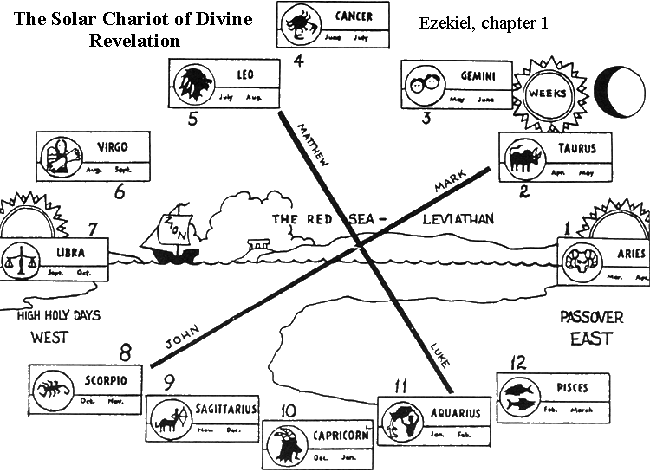
Know that Summer is nigh...Matthew 24 (KJV).
|
|
|
|
|
|
|
Hércules (constelación)
De Wikipedia, la enciclopedia libre
Recibe su nombre del héroe mitológico, Hércules y es la quinta en tamaño de las 88 constelaciones modernas. También era una de las 48 constelaciones de Ptolomeo.
[editar] Características destacables
No tiene estrellas de primera magnitud, siendo la más brillante β Herculis con magnitud 2,78. μ Herculis se encuentra a 27,4 años luz de la Tierra. El Ápex solar (punto del cielo que indica la dirección hacia la que se mueve el Sol en su órbitaalrededor del centro de la galaxia) se encuentra en Hércules, cerca de ξ Herculis.
[editar] Estrellas principales
- α Herculis (Ras Algethi o Rasalgethi), de magnitud 3,31, es un sistema estelar triple, cuya estrella principal es una gigante roja variable.
- β Herculis (Kornephoros), la más brillante de la constelación con magnitud 2,78, una estrella gigante amarilla.
- γ Herculis, gigante blanca de magnitud 3,74. Es una binaria espectroscópica con un período orbital de 11,9 días.
- δ Herculis (Sarin), estrella blanca de magnitud 3,12; es una estrella binaria cuyas componentes han sido resueltas por interferometría.
- ε Herculis, binaria espectroscópica de magnitud 3,91.
- ζ Herculis, la segunda más brillante de la constelación con magnitud 2,89, estrella doble formada por dos estrellas amarillas de desigual brillo.
- η Herculis, gigante amarilla de magnitud 3,49.
- θ Herculis, gigante luminosa naranja de magnitud 3,85.
- ι Herculis, subgigante azul de magnitud 3,79; tres estrellas más completan este sistema estelar cuádruple.
- κ Herculis A y κ Herculis B, dos gigantes que forman una doble óptica.
- λ Herculis (Maasym), gigante naranja de magnitud 4,40.
- μ Herculis, sistema estelar cercano que dista del Sistema Solar 27,4 años luz.
- π Herculis, gigante naranja de magnitud 3,16.
- ρ Herculis, estrella doble cuyas componentes, separadas 4 segundos de arco, brillan con magnitud 4,56 y 5,42.
- τ Herculis, estrella B pulsante lenta (SPB) con una tenue compañera a 7,6 segundos de arco.
- χ Herculis, enana amarilla de baja metalicidad que se encuentra a 52 años luz de distancia.
- ω Herculis (Kajam), de magnitud 4,57.
- 8 Herculis, estrella blanca de magnitud 6,13 que forma una doble óptica con Kappa Herculis —separación 0,2º—.
- 14 Herculis, enana naranja a 59,2 años luz con una enana marrón o planeta gigante alrededor. En 2006 se descubrió un posible segundo compañero, aún sin confirmar.
- 30 Herculis (g Herculis), gigante roja y variable semirregular cuyo brillo oscila entre magnitud 4,3 y 6,3 en un ciclo de 89,2 días.
- 68 Herculis (u Herculis), binaria eclipsante en donde existe transferencia de masa desde la secundaria hacia la primaria.
- 72 Herculis (w Herculis), enana amarilla similar al Sol a 47 años luz de distancia.
- 89 Herculis, supergigante amarilla en las etapas finales de su evolución estelar.
- 95 Herculis, estrella binaria compuesta por una gigante blanca y una gigante amarilla separadas 6,3 segundos de arco.
- 99 Herculis, binaria de baja metalicidad cuya primaria es una enana amarilla de magnitud 5,20.
- 101 Herculis, gigante blanca de magnitud 5,11.
- 109 Herculis, gigante naranja de magnitud 3,84, la duodécima estrella más brillante de la constelación.
- 111 Herculis, estrella blanca de magnitud 4,35.
- X Herculis, variable pulsante semirregular cuyo brillo varía entre magnitud 6 y 7 en un período de 95 días.
- SZ Herculis y FN Herculis, binarias eclipsantes de magnitud 9,94 y 11,08 respectivamente.
- UX Herculis, binaria eclipsante de magnitud 9,05; durante el eclipse principal su brillo disminuye 1,16 magnitudes.
- OP Herculis, gigante luminosa roja variable entre magnitud 5,85 y 6,73.
- HD 147506, subgigante amarilla en donde se ha detectado un planeta masivo (HAT-P-2b) en una órbita excéntricacercana a la estrella.
- HD 149026, estrella subgigante con un planeta cuya masa es similar a la de Saturno.
- HD 154345, enana amarilla a 58,91 años luz con un planeta extrasolar.
- Gliese 623, estrella binaria compuesta por dos enanas rojas.
- Gliese 686 y Gliese 649, enanas rojas a 26,5 y 33,7 años luz respectivamente; la segunda de ellas posee un planeta.
- HD 155358, estrella de baja metalicidad con dos planetas que interactúan gravitacionalmente.
- Gliese 638 y HR 6806, enanas naranjas situadas respectivamente a 31,9 y 36,2 años luz de distancia de la Tierra.
- GD 362, enana blanca con un anillo similar a los de Saturno.
- http://es.wikipedia.org/wiki/H%C3%A9rcules_(constelaci%C3%B3n)

  
ISLA SAN GIORGIO (VENECIA)=GEORGE LEMAITRE
GEMATRIA EN INGLES DE SEED=33
GEMATRIA EN INGLES DE GATE=33
SARA (CE-SAREA DE FILIPO)=PARALELO 33
"¡Oh profundidad de las riquezas de la sabiduría (sophia)
y de la ciencia (gnwsiV, gnosis) de Dios!
¡Cuán incomprensibles son sus juicios, e inescrutables sus caminos!"
(Romanos, 11: 33).
25 DE ABRIL=DIA DE SAN MARCOS
22 DE JULIO=DIA DE MARIA LA MAGDALENA
|
|
|
|
|
PARA NO CREER PERO ESTO ES ASI. LA RELACION DEL DINERO / MONEY / MOON / CON LA LUNA EN EL CONTEXTO A LA TRANSFIGURACION EN EL MONTE HERMON / MON / LUNA EN LA TRIBU DE DAN / DINERO / SERPIENTE. TODO ES UN NEXO CON LA TRANSFIGURACION DEL SEÑOR. DINERO ES TIEMPO MISMO.
ES OBVIO EL NEXO DE LA SERPIENTE CON LA MUJER
NOTEN EL NEXO DE DAN, CON LA SERPIENTE (VENECIA) Y EL CABALLO (PLAZA SAN MARCOS)
7. Génesis 49:17 Será Dan SERPIENTE junto al camino, Víbora junto a la senda, Que muerde los talones del caballo, Y hace caer hacia atrás al jinete.
 1200 1200
|
|
|
|
|
This is a great inspiring article. I am pretty much pleased with your good work. You put really very helpful information. Dr eggman jacket |
|
|
 Primer
Primer
 Anterior
2 a 14 de 14
Siguiente
Anterior
2 a 14 de 14
Siguiente
 Último
Último

|

